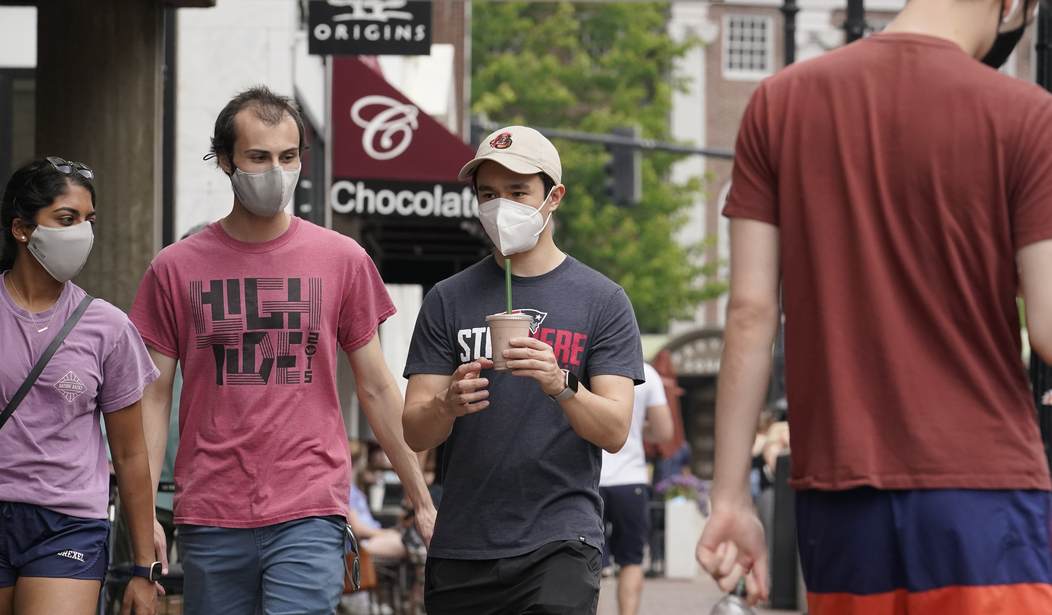I saw a headline about this last night and ignored it, assuming the study wasn’t all that persuasive and that it would only be touted by alarmists hoping to scare vaccine holdouts into getting their shots. I was wrong on both counts. More than one doctor who discussed the findings on television today praised the study’s methodology as compelling. And one of those doctors was Scott Gottlieb, former head of the FDA under Trump, who’s spent much of his time on air over the past few months nudging the CDC to relax its guidance for vaccinated people, not tighten it.
Gottlieb’s not an alarmist. If anything, he’s been the guy who’s been reality-checking the alarmists in the federal science bureaucracy. And he’s concerned about the results here.
The most ominous takeaway is that loss of brain tissue in COVID patients doesn’t appear to correlate to the severity of their symptoms. Even people with “mild cases” had less grey matter after contracting the disease than they did before.
UK Biobank scanned over 40,000 participants before the start of the COVID-19 pandemic, making it possible to invite back in 2021 hundreds of previously-imaged participants for a second imaging visit. Here, we studied the effects of the disease in the brain using multimodal data from 782 participants from the UK Biobank COVID-19 re-imaging study, with 394 participants having tested positive for SARS-CoV-2 infection between their two scans. We used structural and functional brain scans from before and after infection, to compare longitudinal brain changes between these 394 COVID-19 patients and 388 controls who were matched for age, sex, ethnicity and interval between scans. We identified significant effects of COVID-19 in the brain with a loss of grey matter in the left parahippocampal gyrus, the left lateral orbitofrontal cortex and the left insula. When looking over the entire cortical surface, these results extended to the anterior cingulate cortex, supramarginal gyrus and temporal pole. We further compared COVID-19 patients who had been hospitalised (n=15) with those who had not (n=379), and while results were not significant, we found comparatively similar findings to the COVID-19 vs control group comparison, with, in addition, a greater loss of grey matter in the cingulate cortex, central nucleus of the amygdala and hippocampal cornu ammonis (all |Z|>3). Our findings thus consistently relate to loss of grey matter in limbic cortical areas directly linked to the primary olfactory and gustatory system. Unlike in post hoc disease studies, the availability of pre-infection imaging data helps avoid the danger of pre-existing risk factors or clinical conditions being mis-interpreted as disease effects.
There’s no obvious alternate explanation for why those who were infected would consistently have lost brain tissue relative to those who weren’t.
We’ve spent the past 15 months reading about some COVID patients losing their sense of smell or having it change in bizarre ways, making formerly delicious foods smell repellent to them. All along I’d assumed that the virus had done something to affect the receptors in their nose but Gottlieb points out that the new study raises a different possibility: Maybe people can’t smell because they’ve suffered localized damage in the part of the brain that processes scent. Possibly some or all of those cells will regenerate over time or the capacity to smell will be “rerouted” through other brain cells, but if COVID patients are losing grey matter then it’s anyone’s guess what sort of long-term problems they might have. Will they be at greater risk for dementia or other neurological problems later in life?
Watch Gottlieb:
A new study suggests there may be a link between Covid and brain tissue loss. “Seeing anatomical changes as a result of a virus in the brain like this is concerning,” @ScottGottliebMD says. https://t.co/fwgIgU3xWu pic.twitter.com/yY5GQJZqhK
— CNBC (@CNBC) June 18, 2021
Leana Wen is concerned too:
Very worrisome study from the UK showing that those recovered from #covid19 haves signs of long-term changes in their brain. Those who had mild illness & were never hospitalized had these changes too. This really highlights the dangers of this disease—& why vaccination is so key. pic.twitter.com/mqzk3QjkH0
— Leana Wen, M.D. (@DrLeanaWen) June 18, 2021
Both end on the same point. If the virus is causing brain damage of unknown severity then the risks from infection are greater than we had assumed. It’s one thing to let a 20-year-old chance it in the belief that the worst they’ll have to endure is a fever for a few days before shaking it off. It’s another when you know they might lose brain tissue during their recovery. A crucial question that scientists will now need to answer is whether the neurological angle warrants vaccinating children as a precaution against infection even though they almost never have serious complications from the disease. Are kids also losing grey matter to COVID? Because if not, given the tiny but real risk of a serious side effect from vaccination, maybe they’re better off not getting the shot until they’re older:
As of June 10, the government’s vaccine monitoring systems detected 226 cases of myocarditis or a related condition called pericarditis after vaccination in people younger than 30. Normally, fewer than 100 cases would be expected for this age group, said Dr. Tom Shimabukuro, deputy director of the CDC’s Immunization Safety Office…
As the pandemic appears to be winding down across the United States and its limited toll on children has been tallied, it’s no longer clear that immunizing children will bring the outbreak to a faster close, said Dr. Martin Makary, a public health expert at Johns Hopkins University.
Makary is urging his colleagues to “think twice” before recommending universal COVID-19 vaccination of healthy kids. Given the data in hand, “there’s no compelling case for it right now,” he wrote this month in MedPage, a website widely read by physicians.
On the other side of the scale is the fact that more than 450 kids have died of COVID, more than 20,000 have been hospitalized, and more than 4,000 have developed “multisystem inflammatory syndrome in children” after recovering from infection. All of that might have been prevented with vaccination. Now we have loss of brain tissue too — maybe — to worry about in infected kids.
There’s another vaccination question the feds need to answer urgently, especially in light of today’s study. With the B.1.617 Indian/Delta variant spreading quickly here in the U.S. and on its way to becoming the dominant strain, should Americans who received Johnson & Johnson’s one-dose vaccine be running to CVS for a Pfizer or Moderna booster? I ask because B.1.617 is already notorious for being capable of infecting people who’ve received only a single dose of an mRNA vaccine:
***COVID cases, hospitalizations soaring in UK as DELTA wave builds***
Data showing 2 jabs = MUCH better than one:
806 patients w/Delta have been hospitalized — more than doubling in a week
*527* were unvaccinated
*84 had received two doseshttps://t.co/f3fbQIu5St
— Steven Dennis (@StevenTDennis) June 18, 2021
A single dose of Pfizer or Moderna provides roughly 80 percent protection against the original coronavirus while J&J’s single dose provides 72 percent protection. If B.1.617 can evade immunity generated by one mRNA dose, one might assume it can evade J&J as well. In fact, one well-known virologist has already called for J&J recipients to get a booster because of the risk they may be at from B.1.617. If that risk also now includes losing brain tissue, a federal recommendation that they go out and get a second shot becomes that more urgent. So why aren’t we hearing more from the feds about it?








Join the conversation as a VIP Member